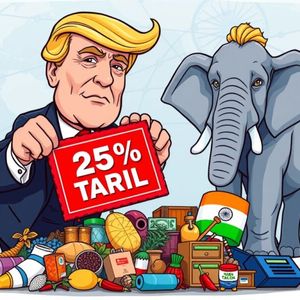
BitcoinWorld US-India Tariffs: Trump’s Bold Move to Impose 25% on Indian Imports and Its Global Ripple Effect In the intricate dance of global economics, even a whisper of trade policy changes can send ripples across markets. For those closely watching the ebb and flow of traditional finance and the burgeoning cryptocurrency space, understanding these shifts is paramount. A recent announcement, initially shared by Walter Bloomberg on X, indicates that former U.S. President Donald Trump plans to impose a significant 25% tariff on goods imported from India if he returns to office. This potential move concerning US-India tariffs isn’t just a headline; it’s a potential game-changer that could redefine trade relations, impact global supply chains, and even subtly influence the volatility and appeal of digital assets. What Exactly Are These Proposed US-India Tariffs and Why Now? At its core, a tariff is a tax imposed by one country on goods and services imported from another country. They are typically used to protect domestic industries, generate revenue, or exert political pressure. The proposed US-India tariffs , specifically a 25% levy on Indian imports, would significantly increase the cost of Indian goods entering the U.S. market. While the announcement comes from a potential future administration, it echoes a consistent theme from Donald Trump’s previous presidency: a strong belief in using tariffs as a tool to address perceived trade imbalances and encourage domestic production. During his first term, the U.S. implemented tariffs on various goods from China and other nations, aiming to renegotiate trade agreements that he deemed unfair to American workers and businesses. This latest proposal targeting India aligns with that protectionist philosophy. The 25% figure is substantial. For context, even small tariff increases can significantly alter the competitiveness of imported goods. A quarter of the import value added as a tax could make many Indian products prohibitively expensive for American consumers and businesses, potentially forcing them to seek alternatives or absorb higher costs. This move is less about generating revenue and more about strategic leverage, signaling a potential shift in the economic relationship between two of the world’s largest democracies. How Will These US-India Tariffs Reshape Global Supply Chains? The immediate and most tangible impact of such substantial US-India tariffs would be felt across various sectors and supply chains. India is a significant exporter of diverse goods to the U.S., including: Pharmaceuticals: India is a major global supplier of generic drugs. Higher tariffs could increase drug prices for American consumers. Textiles and Apparel: Indian textiles are competitive in the U.S. market. A 25% tariff would make them considerably more expensive, potentially benefiting other textile-producing nations or domestic U.S. manufacturers. Information Technology Services: While less about physical goods, trade policies can influence the flow of services and talent. Gems and Jewelry: India is a hub for diamond polishing and jewelry manufacturing. Agricultural Products: Certain Indian agricultural exports could face hurdles. For Indian exporters, a 25% tariff would mean a drastic reduction in their competitiveness in the U.S. market. They would either have to absorb the cost, reduce their profit margins, or find alternative markets. This could lead to job losses in India and a slowdown in its export-driven growth. On the U.S. side, importers and consumers would face higher prices for goods that previously came from India. While the stated goal is to boost domestic production, the transition isn’t seamless. Businesses would need to find new suppliers, either domestically or from other countries, which can be costly and time-consuming. This could lead to: Increased Consumer Prices: Higher import costs are often passed on to consumers. Supply Chain Disruptions: Companies relying on Indian components or finished goods would need to reconfigure their sourcing. Reduced Product Variety: If certain Indian goods become too expensive, they might disappear from U.S. shelves. Ultimately, these tariffs could force a significant reconfiguration of global supply chains, pushing companies to diversify their sourcing away from India or to bring production back to the U.S., a process known as ‘reshoring’ or ‘nearshoring’. Are US-India Tariffs a Threat or an Opportunity for the Global Economy? The imposition of significant US-India tariffs presents a complex scenario with both challenges and potential, albeit limited, opportunities. Challenges: Aspect Impact Inflationary Pressures Increased costs for imported goods can lead to higher prices for consumers in the U.S. Reduced Economic Growth Trade barriers can stifle global trade, leading to slower economic expansion for both nations and potentially globally. Retaliatory Measures India might impose its own tariffs on U.S. goods, escalating into a full-blown trade war. Geopolitical Tensions Economic disputes can strain diplomatic relations between key global players. Supply Chain Vulnerability Forcing companies to rapidly shift sourcing can create new bottlenecks and inefficiencies. Potential Opportunities (often debated and with caveats): Boost to Domestic Industries: U.S. manufacturers in affected sectors might see increased demand for their products. Diversification for India: India might be compelled to seek new trade partners and diversify its export markets, reducing reliance on any single country. Strategic Reshoring: Companies might invest more in U.S. manufacturing, potentially creating jobs, though at a higher cost. Historically, broad tariff impositions have often led to a net negative outcome for global trade and economic stability. While some domestic industries might see a short-term benefit, the broader economy typically grapples with higher costs, reduced consumer choice, and potential retaliatory actions from affected nations. Beyond Trade: How Could US-India Tariffs Influence Broader Markets, Including Crypto? The ripple effect of significant trade policy changes like the proposed US-India tariffs extends far beyond just the immediate goods and services involved. Global markets are interconnected, and economic uncertainty in one area can spill over into others, including the burgeoning world of cryptocurrencies. When traditional trade relations become strained, it often leads to increased volatility in conventional financial markets. Stock markets might react negatively to concerns about corporate profits and economic growth. Currency markets could see shifts as investors move capital in response to perceived risks or opportunities. In times of such uncertainty, investors often seek out assets perceived as ‘safe havens’ or alternatives to traditional investments. This is where cryptocurrencies, particularly decentralized assets like Bitcoin, enter the conversation. While highly volatile themselves, Bitcoin and other digital assets have, at times, demonstrated a low correlation with traditional markets, making them attractive to some investors looking to hedge against geopolitical and economic instability. If US-India tariffs escalate into a broader trade dispute or contribute to global economic slowdown, we might observe: Increased Demand for Digital Gold: Bitcoin is often referred to as ‘digital gold’ due to its finite supply and decentralized nature. In times of economic uncertainty, some investors might flock to Bitcoin as a store of value, similar to how they would traditional gold. Diversification of Portfolios: As traditional investment strategies face headwinds from trade wars and inflation, more investors might consider allocating a portion of their portfolios to cryptocurrencies for diversification. Innovation in Cross-Border Payments: Tariffs can complicate traditional banking and payment systems for international trade. This could indirectly accelerate the exploration and adoption of blockchain-based solutions for faster, cheaper, and more transparent cross-border transactions, circumventing some traditional friction points. While the direct link isn’t always immediate or straightforward, a climate of escalating trade tensions and economic uncertainty can certainly contribute to a narrative that favors decentralized, borderless assets like cryptocurrencies, as they offer an alternative paradigm to traditional, government-controlled financial systems. Actionable Insights for Businesses and Investors In anticipation of potential shifts in trade policy, proactive measures are crucial: For Businesses: Diversify your supply chains. Don’t rely too heavily on a single country or region for critical inputs. Explore options for domestic sourcing or from other trade-friendly nations. For Importers/Exporters: Stay informed about trade negotiations and potential tariff lists. Engage with trade associations and legal experts to understand the implications for your specific products. For Investors: Monitor geopolitical developments and their potential impact on market sentiment. Consider a diversified investment portfolio that includes a thoughtful allocation to alternative assets like cryptocurrencies, understanding their inherent risks and potential for volatility. For Consumers: Be prepared for potential price increases on imported goods. Supporting local businesses can also be a way to mitigate some impacts of international trade shifts. A Shifting Landscape: The Enduring Impact of Trade Policy The prospect of significant US-India tariffs underscores the dynamic and often unpredictable nature of international trade. While the immediate focus is on the economic implications for two major global players, the ripple effect could extend to global supply chains, consumer prices, and even the broader financial ecosystem, including the evolving cryptocurrency markets. As we move forward, adaptability, informed decision-making, and a keen eye on geopolitical developments will be essential for businesses, investors, and individuals alike to navigate this potentially challenging, yet transformative, economic landscape. The narrative of protectionism versus free trade continues to shape our world, and understanding its nuances is key to thriving in an interconnected global economy. Frequently Asked Questions (FAQs) Q1: What exactly is a tariff, and why are they imposed? A1: A tariff is a tax imposed by a government on goods and services imported from another country. They are typically imposed to protect domestic industries from foreign competition, generate revenue for the government, or as a bargaining chip in international trade negotiations to achieve specific economic or political goals. Q2: Which Indian goods would be most affected by a 25% US tariff? A2: While a comprehensive list would depend on specific policy details, historically, key Indian exports to the U.S. that could be significantly impacted include pharmaceuticals (especially generic drugs), textiles and apparel, gems and jewelry, certain agricultural products, and potentially components for the IT and automotive sectors. Q3: How might these proposed US-India tariffs impact the average American consumer? A3: The average American consumer could face higher prices for goods imported from India, such as certain medications, clothing, and electronics. This is because the additional cost from the tariff is often passed on from importers to retailers and, ultimately, to the consumer. It could also lead to reduced availability or variety of certain products. Q4: Could these tariffs lead to a trade war between the US and India? A4: There is a significant risk. If the U.S. imposes substantial tariffs, India might retaliate with its own tariffs on American goods. This escalation, known as a trade war, can harm economies on both sides by reducing trade volumes, increasing costs, and creating economic uncertainty. Q5: What is the potential link between trade tariffs and cryptocurrency markets? A5: While not a direct cause-and-effect, trade tariffs and the economic uncertainty they create can indirectly influence cryptocurrency markets. When traditional financial markets (stocks, bonds, fiat currencies) experience volatility or instability due to trade disputes, some investors may seek alternative assets. Cryptocurrencies like Bitcoin are sometimes viewed as ‘digital gold’ or a hedge against traditional market turmoil, potentially increasing their appeal during such periods. Q6: How can businesses prepare for such trade policy changes? A6: Businesses can prepare by diversifying their supply chains to reduce reliance on single countries, exploring domestic sourcing options, closely monitoring trade policy developments, and consulting with trade experts. Understanding the potential impact on costs, logistics, and market demand is crucial for strategic planning. If you found this article insightful, please consider sharing it with your network! Your support helps us continue to provide timely and relevant analysis on global economic trends and their broader implications. To learn more about the latest global trade trends, explore our article on key developments shaping economic policies and market volatility . This post US-India Tariffs: Trump’s Bold Move to Impose 25% on Indian Imports and Its Global Ripple Effect first appeared on BitcoinWorld and is written by Editorial Team
